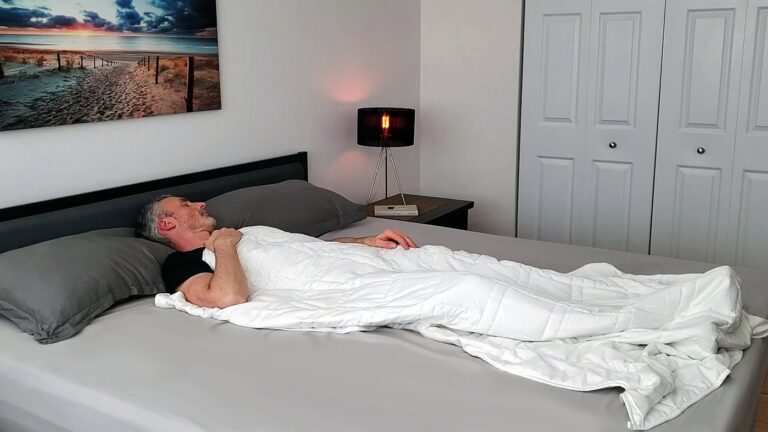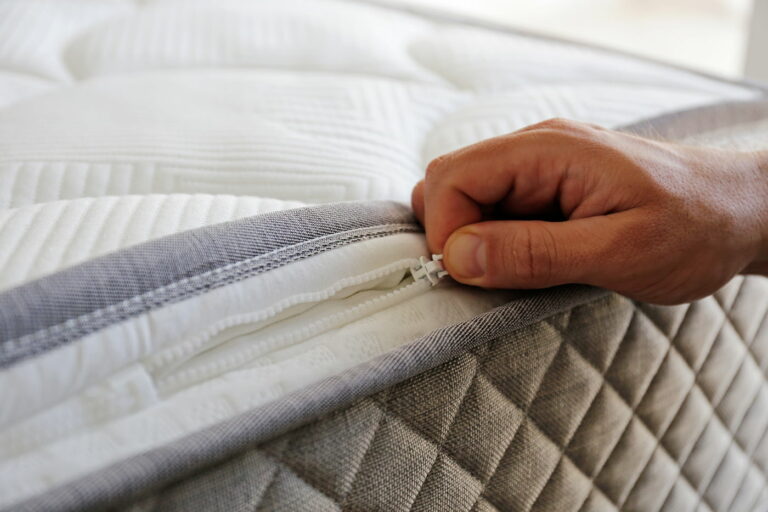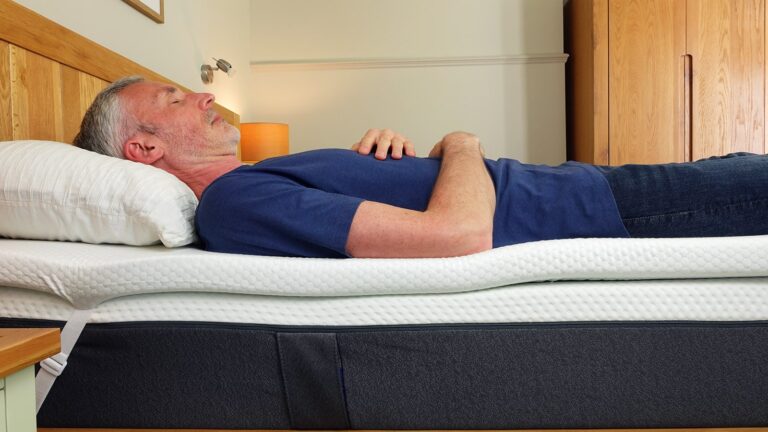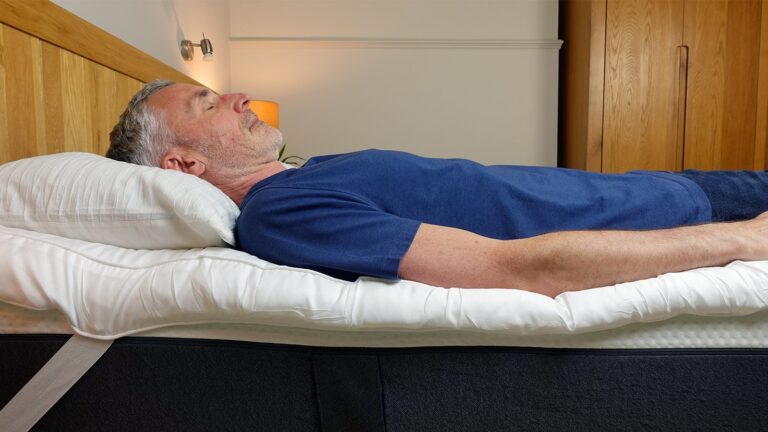Disclosure: My website is reader supported. If you choose to buy a product after clicking a link, I may earn a commission, at no extra cost to you. Learn more.
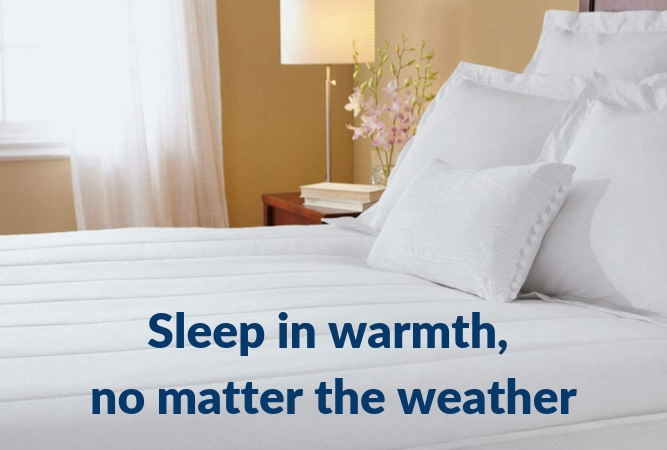
In the icy depths of winter, it always amazes me how a bed can look so cozy, only to give you a shivery surprise when you climb in.
When the world outside is freezing over, heated bedding is an effective way to warm your bed to the exact temperature you need. It can also be more energy-efficient than heating your entire bedroom, potentially reducing your utility bills.
In this review, I’ll be covering some effective and comfortable heated bedding options, with a focus on heated mattress pads. But I’ll also discuss a couple of high-tech bed heating systems, which are interesting alternatives to traditional heated bedding.
Heated pad, blanket, or bed heating system?
A heated mattress pad is arguably a better option than an electric blanket. Having the heat generated under you and the covers is more efficient, and just feels cozier in my experience.
I also like that the elastic skirting keeps a heated pad firmly in place on the bed. Blankets are more likely to bunch up (which isn’t ideal for safety reasons) and can slide around the bed, resulting in uneven heating.
Heated mattress pads come in a wide range of materials and prices, including some reasonable budget options, so you can usually find one that suits your needs.
The high-tech bed heating systems have a wider range of temperature settings, timers, and extra features. They also have the added bonus of doing cooling as well as heating. However, they are significantly more expensive than heated mattress pads, so I’ll discuss those two at the end of the article.
Contents
Heated pads
- Sunbeam Premium Luxury Heated Mattress Pad
- Sunbeam Quilted Heated Mattress Pad
- Electrowarmth
- Sunbeam water resistant heated pad
- Sunbeam fleece heated blanket
Bed heating systems
Extra info.
1. Sunbeam Premium Luxury Quilted Heated Mattress Pad
The best heated mattress pad overall, with dual controls, multiple heat settings, and generous padding.
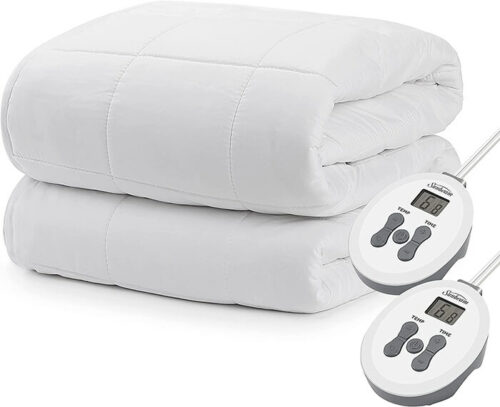
This Sunbeam premium luxury heated mattress pad is my favorite overall for one key reason: it has more fill to pad it out than any other I’ve tried, so it’s comfortable to lie on and you don’t feel the wires underneath you.
Another key comfort point is the 200 thread count 100% cotton top, which has a soft feel under your body. I also like how the fill is neatly boxed into small squares, which means it maintains its shape better than those with long channels.
With 10 heat settings and a preheat function, it does the job of warming your bed very effectively throughout the entire night. There’s also a solid locking mechanism to help keep the cables safely in place and a reassuring auto-off function.
Both the queen and king size have dual zones, so you and your partner can have different temperatures on your side of the bed. Conveniently, it only needs one outlet to power it, even with dual controls.
If your feet reach right to the end of your bed, you might occasionally feel the small lump of the connector port. That’s often the case with heated bedding, and it’s only a minor criticism really.
At the end of the day, the most important point is that this is a heated mattress pad that can reliably keep you snug and warm on even the coldest of winter nights. It currently costs between $110 and $120, depending on the size, and is available in queen and king size.
2. Sunbeam Quilted Heated Mattress Pad
An affordable option with multiple heat settings.

For a lower price than the premium Sunbeam pad, this quilted pad version still gives you the same temperature range, 10 heat settings, an efficient pre-heat function, dual controls for larger sizes, and an auto-off safety feature.
What you won’t get though is so much padding, with just five ounces compared to the nine ounces of the premium version. That means it’s not quite as soft to lie on, and you may occasionally feel the grid of the wires, depending on your weight. It also has a 100% polyester exterior cover rather than cotton, which is less breathable.
The control unit is a no-frills dial, which is very easy to use. It may not look quite as modern as the control units that come with the premium pad, but some people may find the dial version easier to use than buttons when adjusting the temperature in the dark.
On paper, it basically has the same key features as my top-rated pad, so you need to weigh up the balance between cost and comfortable padding. All the sizes currently cost under $120.
3. Electrowarmth
If you’re looking for a particular size, this one comes in the widest range of bed dimensions.
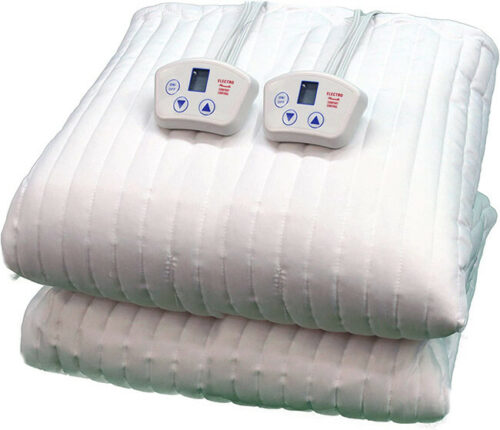
The Electrowarmth is unique in that it’s available in an unusually wide range of sizes, including some that the other brands tend to ignore, like Olympic queen or double extra long.
It has 10 warming settings, just like the Sunbeams. There’s also a rapid pre-heat function that initially heats on the highest setting, then drops to your temperature choice once it reaches it.
It has an auto-off feature after 10 hours, and a safety cut-off if it overheats – both features that help reduce risk. For larger mattress sizes, you and your partner can have separate controls to adjust the temperature just on your side of the bed.
The remote control isn’t exactly the most ergonomically enticing, but at least it’s easy to use and clear which setting you have it on. The price is higher than average, with some sizes costing over $250, so perhaps this is one for those who chose a less common mattress size and need a heated mattress pad to match it.
4. Sunbeam Premium Water Resistant Restful Heated Mattress Pad
A reliable option if you’re worried about spills damaging your mattress.
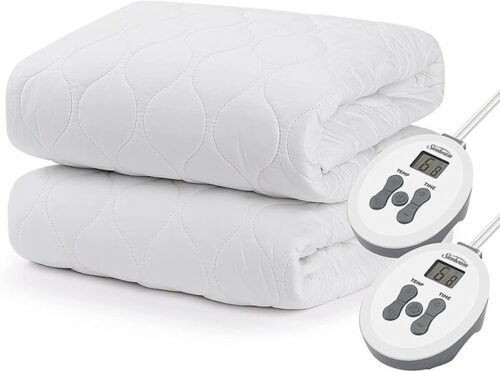
It’s first worth noting that all heated mattress pads need to have a reliable water-resistant casing for the wires to pass standard safety tests. When a manufacturer specifically markets a pad as being water-resistant, it’s really to help prevent catastrophic levels of spillage from reaching your mattress underneath.
This pad from Sunbeam has a 200 thread count 100% cotton top, which gives it a comfy feel. The water-resistant backing should give you the peace of mind to relax and enjoy that comfort.
Like most Sunbeams, you get the standard dual controls for queen size and larger. There are 12 heat settings, and a 12 hour selectable auto-off timer so you can choose how long to have it on for. The heating works well and warms rapidly before you get into bed.
It has six ounces of fill, which is slightly better than the budget option, but not as much as the premium. However, the wires are still well padded and you shouldn’t notice them. If you need to give your mattress some extra protection from spills, this is a good option for a reasonable price.
It’s available in a twin, full, queen, and king, with the price ranging from around $70 to $150 depending on the size you need.
5. Sunbeam Fleece Heated Blanket
If you’d prefer a heated blanket over you instead of a pad under you, this one is cozy and has plenty of heating settings.
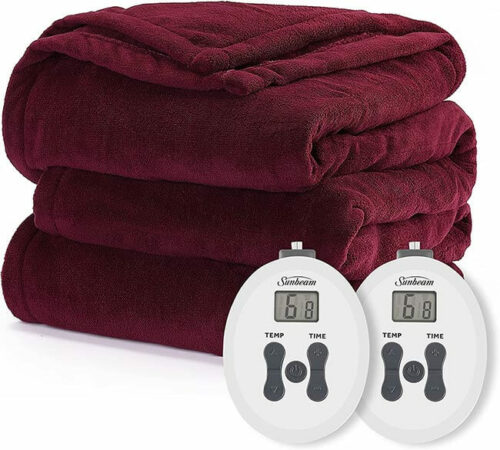
As I mentioned above, my personal preference is for a heated mattress pad or a heating system that doesn’t put wires in your bed at all. However, if you like electric blankets, the Sunbeam Microplush is a good option.
The material itself feels lovely and soft, which makes up for the fact that you can just about feel the wires if you lay your arm on top of the blanket.
It has 12 heat settings and a pre-heat, so you’ll be able to find just the right temperature to keep you feeling cozy. And like many Sunbeams, it has a 12 hour selectable auto shut-off feature.
The controllers are easy to use, with simple buttons to adjust the temperature and timer. For queen size or larger, you’ll get two controllers so one person won’t be sweating at night while the other is enjoying their fabric tropical cocoon.
One issue is the potential for it to slide around or even off the bed because of the slippery fabric, which can create uneven heating. Be careful not to let it bunch up, and machine wash it exactly as per the instructions to limit the risk of any damage occurring.
It’s available in throw, twin, full, queen, and king size, with the price ranging from around $45 to $85. Note that there are different colors to choose from, some of which are less expensive if you want to save some money.
6. Eight Sleep Pod 3 Cover
An app-controlled smart bed heating and cooling system that circulates water through a mattress pad.
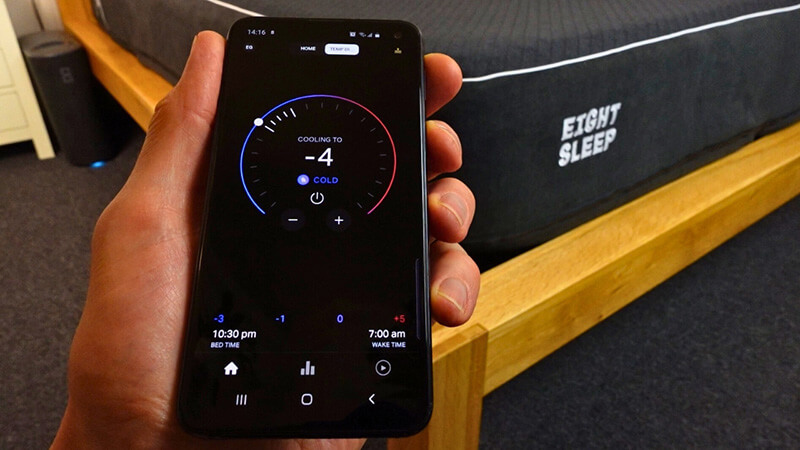
Let’s take a look now at the first of the two bed heating systems – the Eight Sleep Pod 3 Cover. In the photo above, I’m using the smartphone app to control the temperature on the Pod I have set up in my bedroom.
It was very good at keeping me cool last summer, and the gentle warmth was nice in the coldest part of the winter. My partner absolutely loved using the heating throughout the autumn, winter, and spring of 2023/2024.
In contrast to the heated mattress pads, the Pod heats water in the hub unit that then circulates through a network of thin silicone tubes nestled in a comfortable mattress cover.
The Eight Sleep Pod 3 Cover lets you set the surface temperature of the pad in the range of 55-110°F / 13-44°C. A user-friendly companion app gives you the option to make quick temperature adjustments, as well as the ability to program different temperatures throughout the night to sync with your sleep cycle.
In the photo below, I’m setting up the Eight Sleep Pod in my bedroom. The process took a few hours as the system needs priming. But it was well worth the effort as I’ve been very impressed with its heating and cooling capabilities.
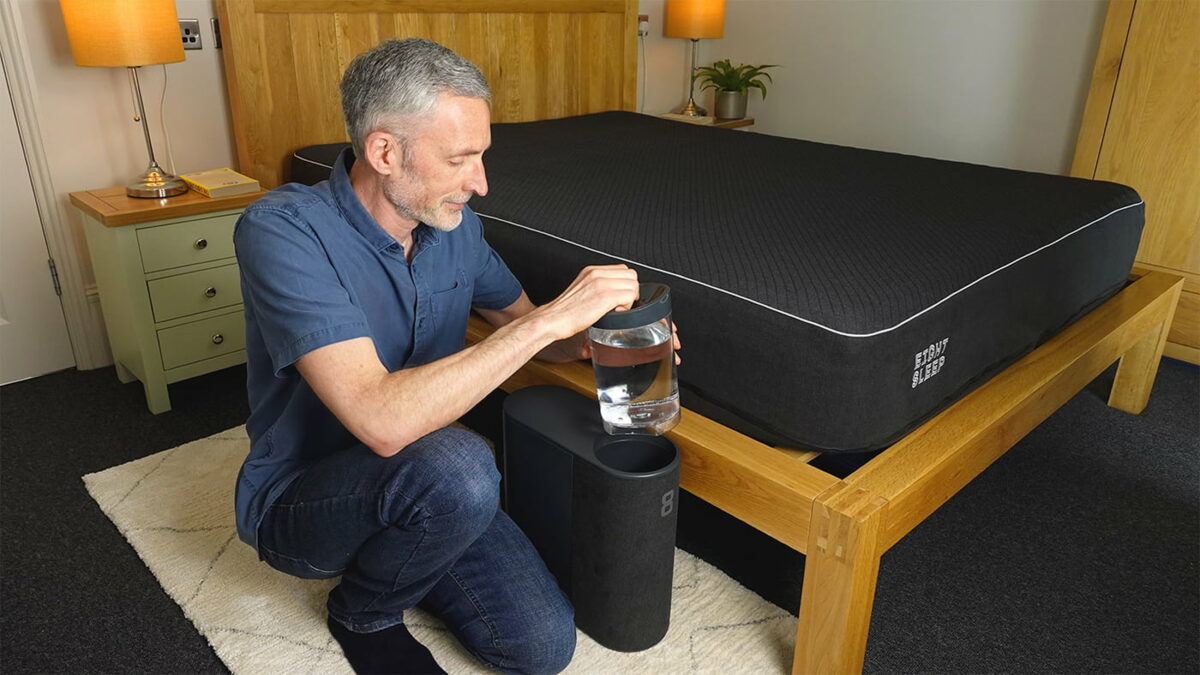
With dual zones built into the mattress pad, it allows independent temperature control on each side of the bed. This means you and your partner could enjoy warmth on one side and cooling on the other – all at the same time.
The Eight Sleep Pod 3 Cover also has an extensive set of smart features, grouped into what the company calls ‘autopilot’. Using biometric tracking, it learns your sleep habits and actively adjusts the bed temperature in real time to help you stay comfortable and sleep better.
Given the advanced technology incorporated into the Eight Sleep Pod 3 Cover, it’s expensive, costing between $2095 and $2495 depending on the bed size and cover style you need. So this is a luxury product that’s likely only going to be available to those with a larger budget.
Update: the Pod 4 is now available, which can reach even cooler temperatures (not so relevant to people reading about bed heating perhaps!) and is quieter to run.
7. BedJet 3
If you’d rather not have any wires or tubes under or over you, the high-tech BedJet 3 blows warm air under the covers.
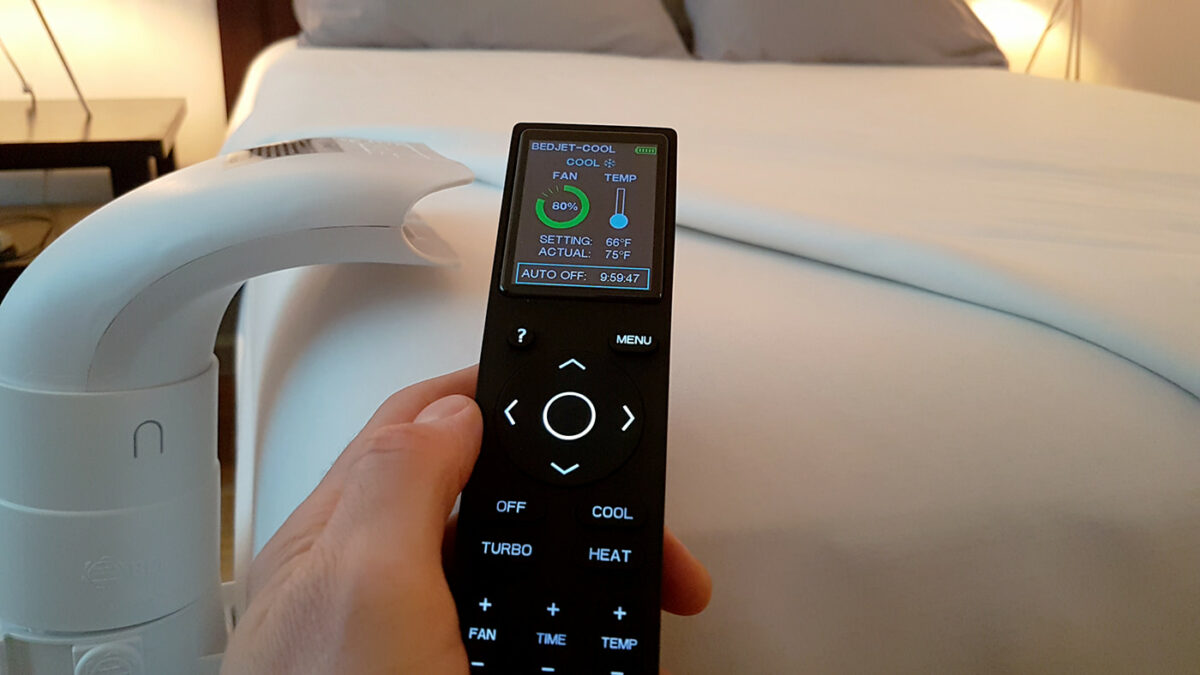
If you’d like to warm your body and bed, but are concerned about the safety of sleeping on a mesh of wires that heat up, the BedJet 3 is an effective alternative.
Were price no concern, I would recommend it over traditional heated mattress pads; it really is very effective in the frosty grip of winter. But since this review was primarily about heated pads, I thought I’d save this gem to the end.
The BedJet 3 works by heating air within a unit adjacent to your bed and channeling it between your existing sheets or into a specialized sheet. So you can choose to have the warm air flowing directly over your skin, or inside the sheet you lie under.
In the photo below, I’m demonstrating how my BedJet 3 works in my previous bedroom. The air flows out of the tube, which you can position where you like to target different parts of your body. It’s great for warming cold feet!
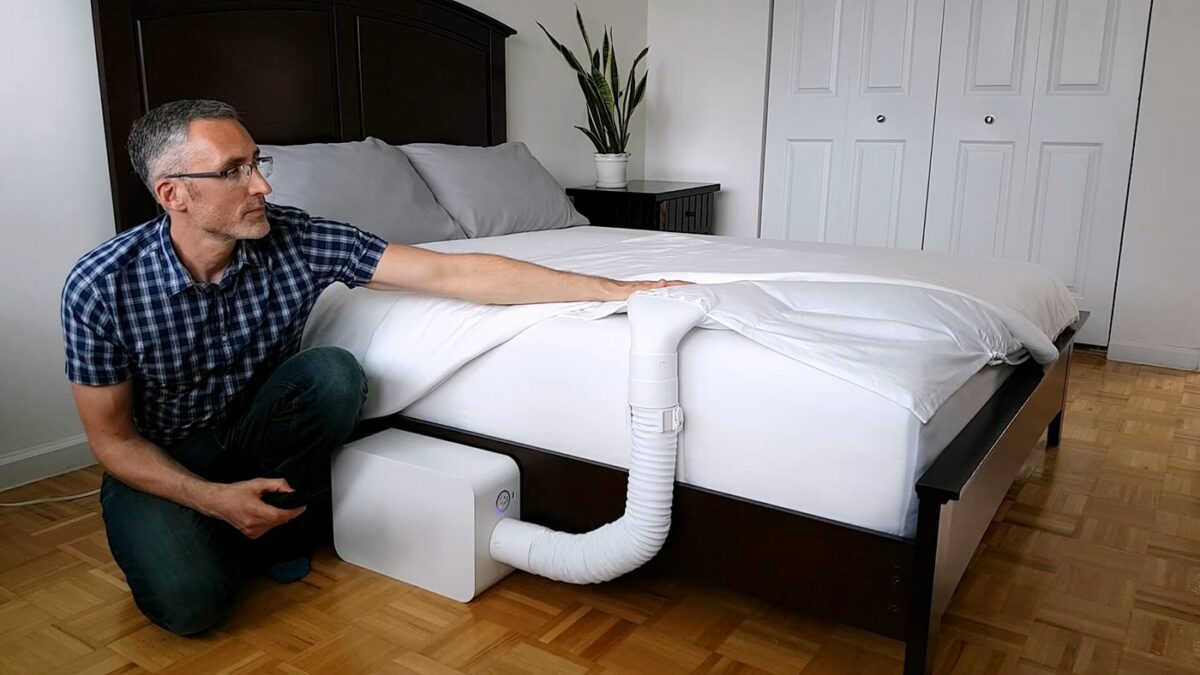
It’s a joy to use, especially if you struggle with the feeling of getting into a chilly bed. One key point is that it also does cooling, and even lets one person heat their side while their partner cools the other. So in that way, there’s similar flexibility for bed partners as the Eight Sleep Pod 3 Cover.
With an advanced remote control that makes standard heated bedding controls look like 1990s games console joysticks, this is again one for those with a bigger budget and a love of tech.
It typically costs just under $500 for a single unit and just under $900 for the dual-zone version. The listed base price is higher, but BedJet have regular sale prices throughout the year.
Heated bedding buying guide
If you’re confused by all the options out there or have a question about using heated bedding, hopefully you’ll find this section useful.
The heating element
Five of the seven products in this article heat using wires encased in fabric bedding, which is standard for pads and blankets.
I think it’s usually a good idea to find ones that have thinner wires and/or a more generous amount of fill that stops you from feeling them. This is one of the key points I looked at when researching for this review. There’s quite a big difference between five and nine ounces of fill, for example.
The Eight Sleep Pod 3 Cover contains tubes nestled within the mattress pad that circulate heated water, so there are no electrical wires underneath you. The BedJet 3 pumps warm air out of a tube on the side of your bed, so there are no wires or tubes at all under your covers.
The controller
Every heated pad and blanket includes an attached controller, typically connected via a cable. The Eight Sleep Pod can only be controlled with an app, and the BedJet 3 either with the physical remote control or an app.
The design of the traditional heated mattress pad controllers varies, often appearing somewhat dated and lacking aesthetic appeal, in my opinion. They are usually very easy to use though – either a turn dial with numbers or a small screen saying little more than the number it’s set on.
For queen size and larger, dual controllers are standard, allowing you and your partner to personalize the temperature on your side of the bed. While this system generally functions well, managing the temperature in the middle of the bed can be tricky due to the combined heat from the pad and your bodies.
Cover material and fill
The material for heated mattress pad covers usually falls into three categories: cotton, polyester, or a blend of the two.
Cotton is often preferred for its breathability, which can help mitigate the build-up of sweat or moisture when using the pad. However, it’s worth mentioning that not all cotton is the same. For instance, high-quality, long-staple cotton will likely perform better than lower-quality varieties.
Polyester, particularly in its microfiber form, tends to be stretchier and can feel softer to the touch. You’ll often see electric blankets marketing their “plush” or “velvet plush” polyester materials to highlight their softness.
The fill is also important in how a pad will feel to lie on. The amount and type of fill can affect how noticeable the heating wires are through the pad or blanket. However, the thickness of the fill can’t be increased indefinitely, as it needs to allow heat flow and meet safety standards.
Manufacturers will usually indicate the amount of fill in their product descriptions. If possible, aim to find a pad with five or more ounces of fill for a queen-sized pad or larger. Keep in mind that the right amount of fill can vary depending on personal comfort preferences and the specific construction of the heated pad.
Heating options
When looking at various heated pads and blankets, you’ll often find a similar set of features across most manufacturers. Typically, they have around 10-12 heat settings, giving you enough flexibility to adjust the warmth to your preference.
Though you might occasionally come across heated bedding with up to 20 heat settings, the difference is arguably minimal. Having at least 10 settings should be enough for most people.
Another common feature is the pre-heat function. While you can technically pre-heat your bed simply by turning the heated pad on earlier, the pre-heat function makes life a bit easier. It sometimes includes a timer, ensuring your bed is warm when you’re ready to sleep and preventing the pad from overheating or staying on unnecessarily long. It’s a useful feature that improves both comfort and safety.
Safety
All of the heated pads and blankets in this review are either UL or ETL certified, meaning they have been tested as safe by an independent entity. If you’re shopping within the United States, always look for one of these certifications.
Manufacturers are obviously concerned that their products are both safe, and perceived as safe by consumers. So they make sure they include reassuring safety features such as an auto-off function, typically set at 10-12 hours, and overheating detection with automatic shut-off.
My advice would be to skim through the bad reviews on customer sites like Amazon. You’ll find most people give one star just because it stopped working at some point. But if you do find complaints about electrical defaults, I would avoid it!
And in terms of looking after your heated bedding yourself, make sure you’re careful to check it for defects when you first buy it. Clean it exactly according to the manufacturer’s instructions. Store it carefully off-season so it doesn’t bunch up. And if you have any suspicion that there might be a default, use the warranty to get it checked out.
For more about safety, the Wirecutter website has a useful section about this, including an interview with a UL safety testing director. Interestingly, they also test the cost-efficiency of heated bedding compared to whole room heating.
Cleaning
Most heated pads are machine washable and can even be dried, which in my experience, is more convenient than spot cleaning. However, they typically require a specific cycle and should only be washed when absolutely necessary.
Typically, the recommended cycle is a brief, cold wash – so don’t just toss it in with your regular laundry! Then the drying will either be very short and cooler, or air-dried only.
As well as following the instructions, I’d be careful that your machine does what it says it does. Our latest dryer, for example, heats too high even on settings that are supposed to be cooler, which could damage the wiring of the heated pad.
Warranty
Every product I’ve discussed in this article comes with a minimum one-year warranty, with some extending up to five years. I think this is an important point, so I highly recommend checking yours has a good warranty.
It’s also great if a trial period is offered, ideally with a no questions asked returns policy so you can check it meets your expectations before fully committing to spending your money on it.

